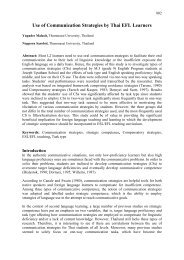The Effects of Semantic Mapping on Vocabulary Memorizing
The Effects of Semantic Mapping on Vocabulary Memorizing
The Effects of Semantic Mapping on Vocabulary Memorizing
You also want an ePaper? Increase the reach of your titles
YUMPU automatically turns print PDFs into web optimized ePapers that Google loves.
learning also indicated that vocabulary learning was no l<strong>on</strong>ger a student’s self-study but <strong>on</strong>e <str<strong>on</strong>g>of</str<strong>on</strong>g><br />
the key c<strong>on</strong>cepts for language acquisiti<strong>on</strong>.<br />
However, <strong>on</strong>e student admitted that she felt it difficult to follow the c<strong>on</strong>structi<strong>on</strong> <str<strong>on</strong>g>of</str<strong>on</strong>g> semantic<br />
maps and could not remember words well with maps. This could be explained that the instructi<strong>on</strong><br />
<str<strong>on</strong>g>of</str<strong>on</strong>g> how to use the semantic mapping was not always clear for all <str<strong>on</strong>g>of</str<strong>on</strong>g> the students in the study. This<br />
student might be misunderstood some stages <str<strong>on</strong>g>of</str<strong>on</strong>g> using the semantic mapping. <str<strong>on</strong>g>The</str<strong>on</strong>g>refore, the<br />
teacher should be more careful in introducing the semantic mapping to the students. One more<br />
soluti<strong>on</strong> to help the student remember words better with maps could be encouraging her to<br />
involve in regular learning, using both the semantic mapping and the word lists if necessary.<br />
2. Pedagogical implicati<strong>on</strong>s<br />
In this secti<strong>on</strong>, based <strong>on</strong> the findings in the gain in the students’ vocabulary retenti<strong>on</strong> and the<br />
students’ positive attitudes towards using semantic mapping, some implicati<strong>on</strong>s might be<br />
c<strong>on</strong>sidered.<br />
First, the ultimate goal <str<strong>on</strong>g>of</str<strong>on</strong>g> vocabulary instructi<strong>on</strong>s is to help students become independent<br />
learners who have strategies for discovering, remembering, c<strong>on</strong>solidating new words. This goal<br />
cannot be achieved without teachers’ efforts. Teachers should motivate students in their<br />
vocabulary memorizing with different vocabulary tasks. <str<strong>on</strong>g>The</str<strong>on</strong>g>y should provide students with not<br />
<strong>on</strong>ly vocabulary knowledge but also the strategies to access, to memorize and to c<strong>on</strong>solidate the<br />
knowledge.<br />
Sec<strong>on</strong>d, to be effective, explicit vocabulary instructi<strong>on</strong>s should be dynamic and include a variety<br />
<str<strong>on</strong>g>of</str<strong>on</strong>g> techniques. Specifically, vocabulary instructi<strong>on</strong>s should (1) use both definiti<strong>on</strong>al and<br />
c<strong>on</strong>textual informati<strong>on</strong> about word meanings, (2) involve students’ activity in word memorizing<br />
and (3) use discussi<strong>on</strong> to teach the meanings <str<strong>on</strong>g>of</str<strong>on</strong>g> the new words to provide meaningful<br />
informati<strong>on</strong> about the words. It is noticeable that students can use their mother t<strong>on</strong>gue to discuss<br />
the meanings <str<strong>on</strong>g>of</str<strong>on</strong>g> the new words. In this case Dash (2000) explained that students’ first language<br />
could be c<strong>on</strong>sidered as a language tool that promote the process <str<strong>on</strong>g>of</str<strong>on</strong>g> L2 penetrating quickly.<br />
3. Limitati<strong>on</strong>s <str<strong>on</strong>g>of</str<strong>on</strong>g> the study<br />
Although the research has reached its aims, there were some unavoidable limitati<strong>on</strong>s.<br />
First, because <str<strong>on</strong>g>of</str<strong>on</strong>g> the shortage <str<strong>on</strong>g>of</str<strong>on</strong>g> time, it was difficult for the research to reinforce the semantic<br />
mapping through the whole book. In additi<strong>on</strong>, the implementing semantic mapping was short<br />
because it was c<strong>on</strong>ducted in the vocabulary teaching stage during five weeks. <str<strong>on</strong>g>The</str<strong>on</strong>g> time limit also<br />
resulted in a small size <str<strong>on</strong>g>of</str<strong>on</strong>g> populati<strong>on</strong> involved in the study. <str<strong>on</strong>g>The</str<strong>on</strong>g>refore, in order to generalize the<br />
results for larger groups, the research should be extended its time and the study should have been<br />
involved more participants at different levels.<br />
Sec<strong>on</strong>d, the high school students’ overloaded study might be the factor that affected the results <str<strong>on</strong>g>of</str<strong>on</strong>g><br />
the study because the students were usually under study pressure from studying a lot <str<strong>on</strong>g>of</str<strong>on</strong>g> subjects.<br />
Third, because <str<strong>on</strong>g>of</str<strong>on</strong>g> the time limit, there was <strong>on</strong>ly <strong>on</strong>e test <str<strong>on</strong>g>of</str<strong>on</strong>g> vocabulary retenti<strong>on</strong> used in the<br />
present study. <str<strong>on</strong>g>The</str<strong>on</strong>g>re should have had some progress tests or delayed tests to measure students’<br />
vocabulary memorizing in l<strong>on</strong>ger intervals <str<strong>on</strong>g>of</str<strong>on</strong>g> time.<br />
655






